American Goldfinches aren’t supposed to be insect eaters but apparently this male didn’t get the memo.
In yesterday’s post I mentioned that three days ago I’d photographed both Yellow Warblers and an American Goldfinch on thistles as they were feeding on insects. Late yesterday Dan Gleason made a comment on that post that included the following:
- “You mentioned that the birds were eating the insects on the thistle, but in the case of the Goldfinch, that would not be the case. Insects are eaten by goldfinches only as an accident. They will not deliberately seek insects for food. Nearly all songbirds take insects to feed their young as seeds are hard to digest and insects provide easily available protein. But American Goldfinches are an exception feeding raw seeds from day one.”
When it comes to birds Dan knows his stuff. Before he retired he taught ornithology on the college level for over 30 years, he and his wife Barbara own a Wild Birds Unlimited store in Oregon and he regularly provides knowledgeable, insightful and reliable natural history information about birds in his comments to my posts so what he said gave me pause. Maybe I didn’t see what I thought I saw. So I did some further research and looked at my photos much more carefully.
Cornell’s Birds of the World largely backs up what Dan said. Here’s their take on what American Goldfinches eat:
- “Seeds of many annual plants, Compositae preferred, and small seeds of various tree species, including alder (Alnus), birch (Betula), northern white-cedar (Thuja occidentalis), and elm (Ulmus). Prefer black thistle among feeder seeds, but will take sunflower (shelled or as hearts; KJM). Insects only as encountered.”
To me “insects only as encountered” suggests that goldfinches rarely eat insects and only when they happen upon them accidentally in their search for their normal diet of seeds, which is pretty darn close to what Dan said – insects eaten “only as an accident.” My takeaway from both Dan and Birds of the World is that American Goldfinches are not known to deliberately seek out insects as food.
But that’s certainly what this male goldfinch was doing in the Wasatch Mountains three days ago.
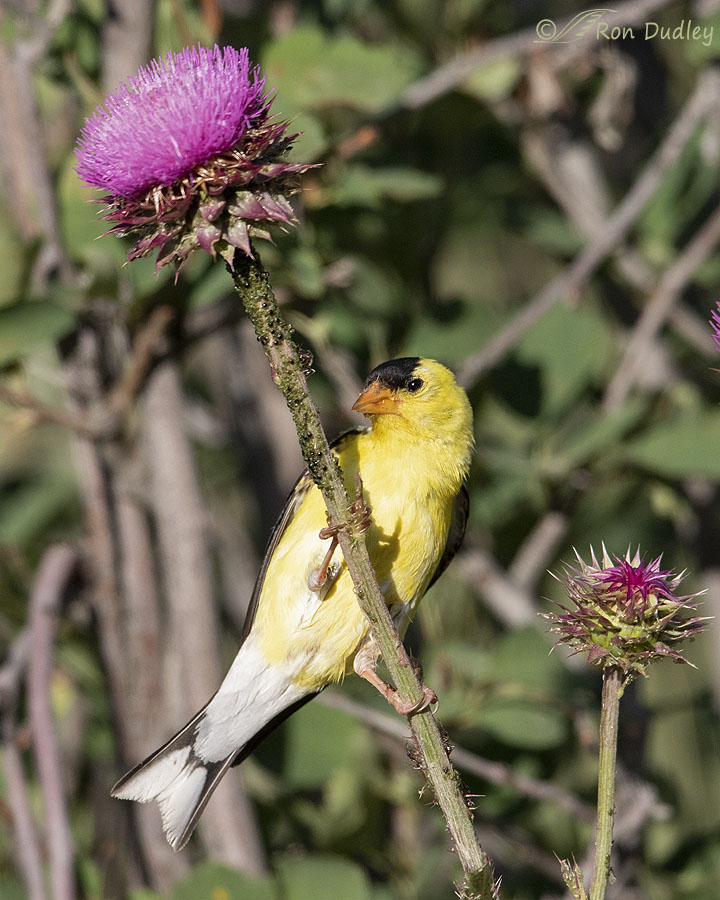
I found him on thistle that was literally crawling with both aphids and the ants that attend them.
Some of the following photos of this bird are lacking in quality because they’re all huge crops (only 6% of the original image, 1.2 MP of 20 MP) and because for some reason my photos of him weren’t quite as sharp as usual. I don’t know why, it just happens sometimes.
But they’re plenty good enough for documentary purposes.
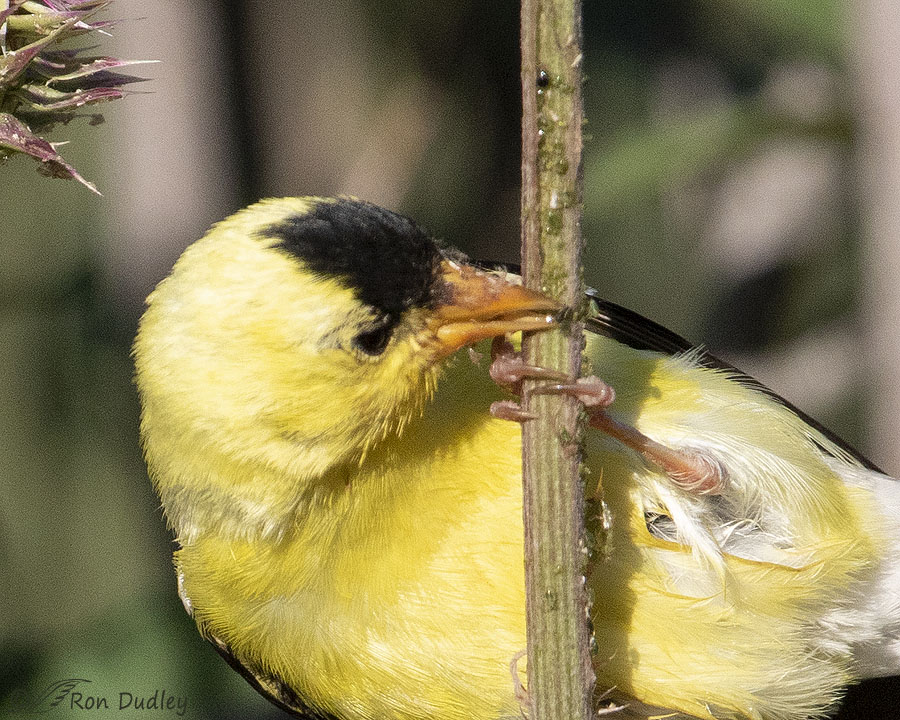
Aphids come in a variety of sizes and colors and some have wings. Here the goldfinch appeared to be picking off one of the darker ones.
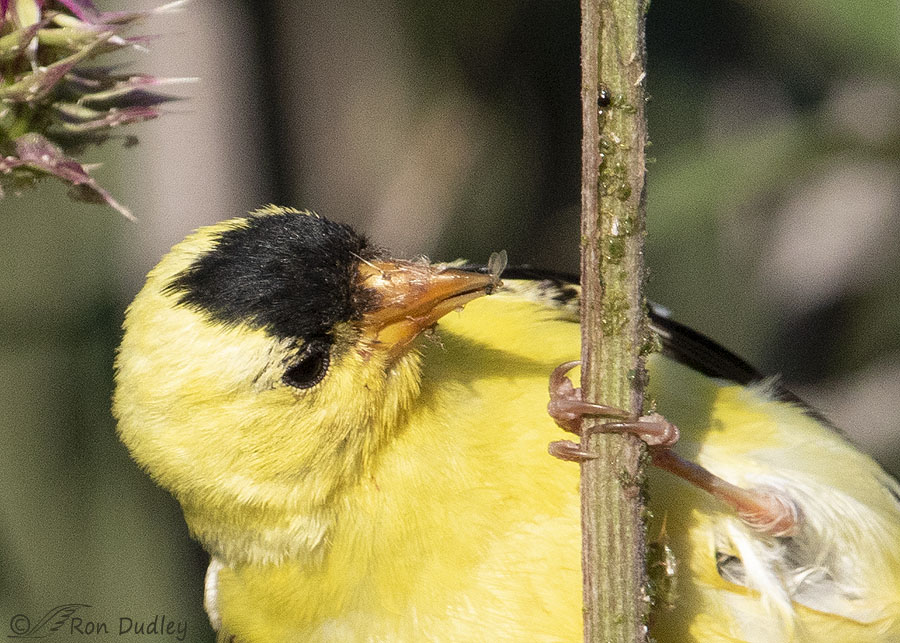
In the next shot in the burst that aphid is gone from the thistle stalk and is now in the bill of the goldfinch. It also appears to have wings.
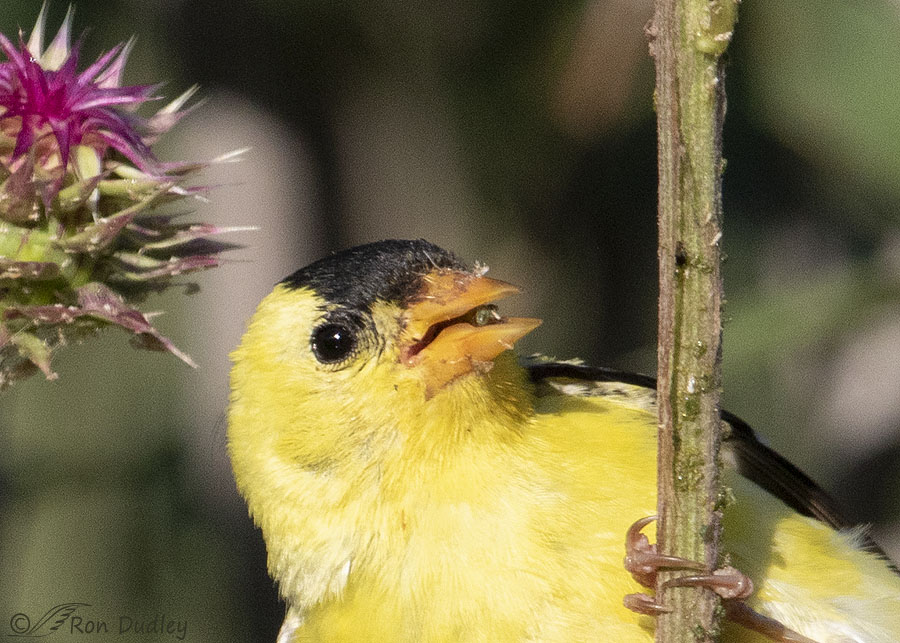
Two frames later he’s about to swallow the aphid.
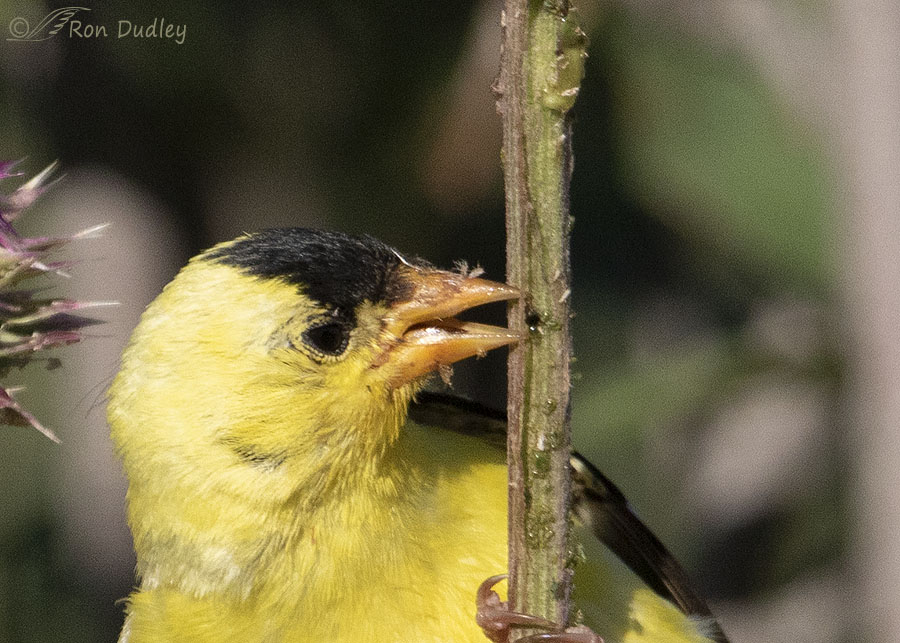
Then he went after the other dark aphid higher up on the stalk.
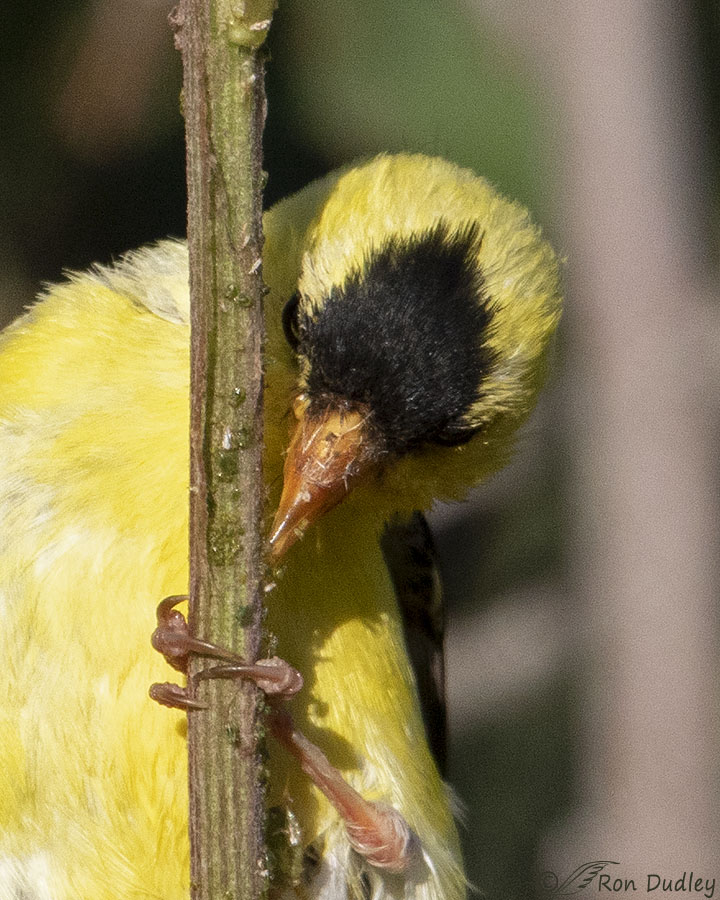
But he didn’t discriminate against the green aphids, he ate them too.
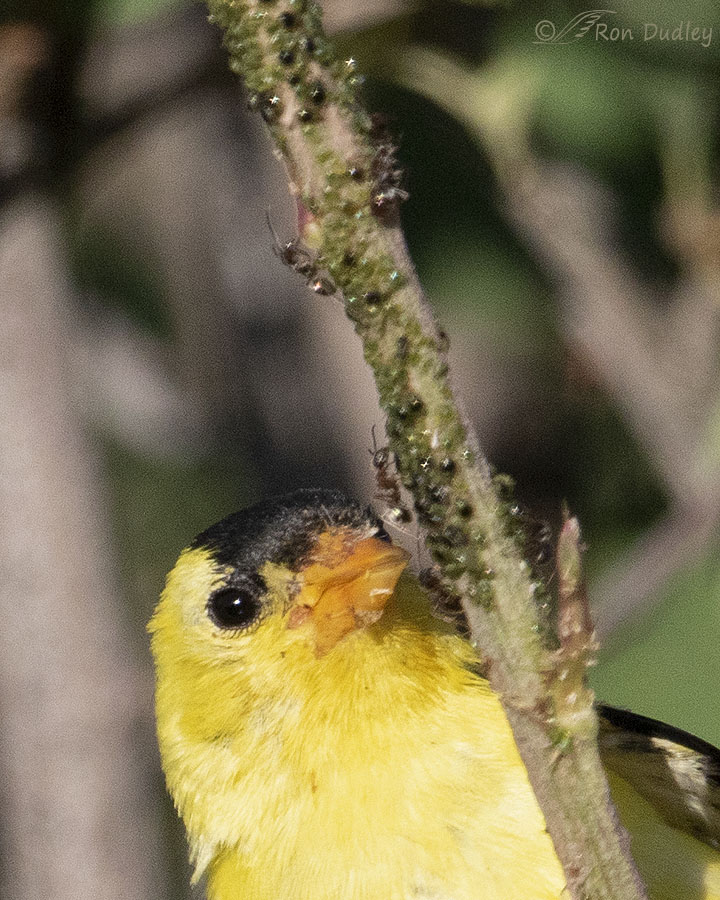
He seemed to completely ignore the ants and only eat aphids. Immediately after this shot was taken his bill was directly behind the thistle stalk where I couldn’t see it but based on the movements of his head I’m sure he was gobbling down aphids. A few frames in the burst later….
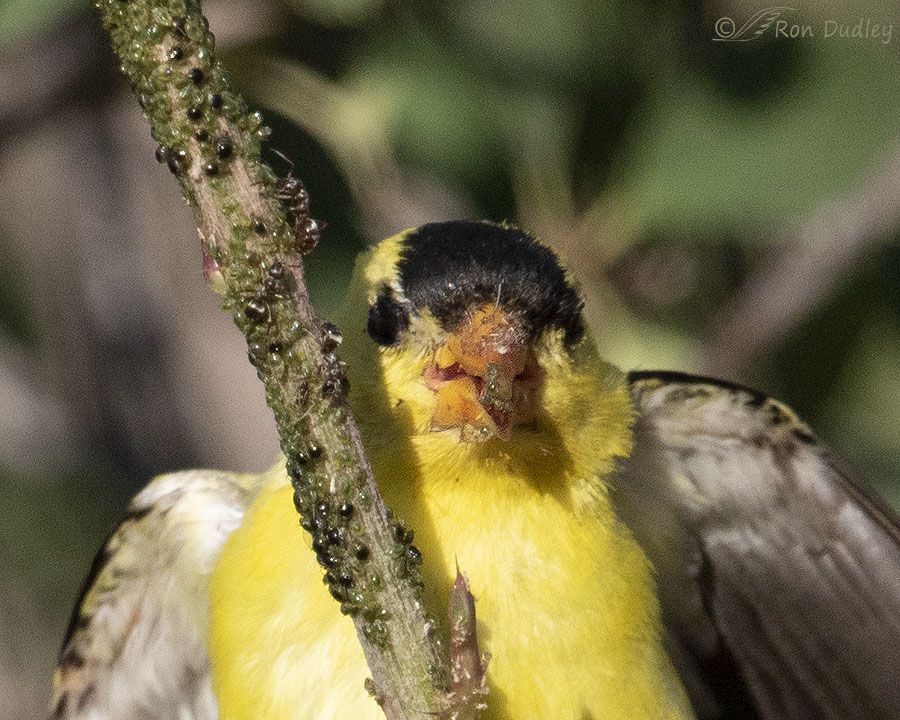
his bill was covered with green aphids as he raised his wings to aid in turning on the perch.
In the roughly two minutes I spent with this bird on the thistle I took 120 photos of him as he very deliberately searched for aphids and ate them. He never once closely approached a flower head where seeds would be found, instead he was always lower on the stalk where the aphids and ants were. I’m convinced that he was deliberately seeking out aphids as food rather than encountering them accidentally during a search for seeds.
As Dan told me in an email last night ‘There are always interesting exceptions to the norm so it’s never safe to make blanket statements.”
I’m pretty happy to have documented an unusual behavior and that Dan helped me to realize it so I wanted to share some of the photos with my readers.
Ron


Glad I am not going crazy. Took the picture in the link below today of a female American Goldfinch picking Oleander aphids off a Sullivant’s Milkweed and eating them. I wish I would have made an effort to get some better shots, but I honestly did not know what she was eating until I looked at the pics and I only took them because I was curious. The plant she was on is just starting to bloom and so no seedpods to be found but she was clearly feasting on something. She spent a good several minutes eating the aphids. I was so confused because I also always believed that goldfinches are strict vegetarians. A google search for answers brought me here.
https://nativesuburbia.com/gallery/closer-look/?id=240&imgs=240
Interesting. A couple months ago I caught a Lazuli Bunting feeding on some aphids. Didn’t make the discovery until I got home to look at the photos.
Sometimes I’ll see seed-eaters bringing insects to feed their young, but this bird was in the nest-building phase at the time.
Always fun to see what these guys are up to.
Fascinating!!!! I have goldfinches that sometimes come to my yard. They congregate at my neighbor’s feeder. That last shot is funny to me. Messy eater!
Laura is right. My comments to your posts should ALWAYS start with wow and end with thank you. That is a given.
Huge thanks to your commentators too. It is just after 4 am here and I have wondered, I have learned, I have laughed.
Like Marty I am itching (and trying hard not to scratch) after reading this post, but smiling broadly.
EC, I was up at 4 today too but then I usually am. Makes for a long day, especially when fireworks keep you awake (holiday weekend here) but a nap helps. I just woke up from mine. Thank you.
I am usually up around then too. And loathe having what sleep I get disturbed.
What an entertaining (and highly educational) post today, reader commentary included! Love to see these closeups of the feeding finch — he looks quite satisfied with his chosen meal and I’m happy for him, whether he’s “supposed” to be eating aphids or not! Congratulations on an (apparently) unusual find, Ron. (I spotted a common yellowthroat in my backyard fountain today, for me a highly unusual find! 😉)
Thanks, Chris. I only rarely see Common Yellowthroats. I think the males in breeding plumage are pretty neat looking little birds.
I’ve learned that it’s unwise to use the words always and never. There’s almost always somebody/something that will prove you wrong! And Mother Nature likes to hold her cards close to her vest, unwilling to reveal ALL her secrets, and as Judy Gusick noted, “critters will make liars out of you every time!”
Dick Harlow’s “sweet fix” observation also hits home. I’ve made the same observations that helped me formulate the aversion to pontificating the words always and never.
I’m also drawn to Kris Eberhard’s comment where she wonders “if those juicy-looking aphids would be more appealing during a drought.” I’d think that’s quite possibly part of the complex motivations for goldfinches to add aphids to their diet. Raptors, for example, get the bulk of their moisture/fluid from the blood of their prey, however, if they get the opportunity, they will drink water from other sources. We’re all drawn to what our bodies need, and as I’ve often said, we’re far more alike than we are different.
I always look forward to Dan Gleason’s posts. In fact, I don’t have the words to express my gratitude that this is a place where learning happens paired with the sheer beauty of critters–mostly birds, but other wild folk, too. Even in my dotage, I want to learn at LEAST one new thing every day. Now, obviously that comes with a challenge. Every new thing learned opens up at least a dozen new questions. I love that about curiosity. It’s dynamic and ongoing–well it SHOULD be ongoing! If it’s not, that’s one of the first indications of a stalled and rigid intellect. That’s a bad thing!
Oh and just because I haven’t commented over the past couple of days does NOT mean I haven’t been watching. I just LOVED the barn swallow/kingfisher series! It was BRILLIANT!!
BTW, I’d like to stipulate an opening “Oh WOW” comment along with a hearty “thank you” every day if you don’t mind. That’s one of those precious few ALWAYS moments 😉
“I always look forward to Dan Gleason’s posts”
As do I, Laura. Dan has some serious health problems, some of which affect his vision negatively and significantly, but he still comes on board regularly and shares his vast knowledge of avian natural history.
When Dan comments it’s very often like sitting in a college postgrad ornithology class and not having to pay tuition!
Thanks for all of the very kind words. One of my passions is teaching and sharing my knowledge with others and in the process, learning new things myself. I love being around people who enjoy all of the natural wonders that surround us from our backyards to the wilderness. There have been some health challenges in recent years. The biggest of those was last year’s battle against leukemia. I beat it, even if the chemo cost me my eyes. All that matters is that I’m here and I love life and all of the challenges it offers. And low vision is just one more new challenge, not an obstacle to stop me. I’m here to keep extending my knowledge and experience with nature and to share it with others. If you will permit me, I will continue to share here and elsewhere, not because I’m an “expert”, but because I’ve learned some really cool things in this life and I’d love to have the opportunity to have others learn about them too. Thanks for hearing me and thanks for your kindness.
Sending ((((HUGS)))) to both you wonderful guys! My sincere THANK YOUs!
Between yesterday and today I’ve gotten quite an education on the American Goldfinch, Yellow Warbler, thistles, aphids, bindweed and more. Thanks for that.
Now, I’m waiting for a photo of a Red-tailed Hawk eating serviceberries.
“Now, I’m waiting for a photo of a Red-tailed Hawk eating serviceberries”
Don’t hold your breath on that one, Lyle. However one red-tail population in Mexico is known to specialize in land crabs which I think is fairly unusual.
Yep, Mr. Goldfinch definitely did not get the memo. What a treat to be able to get up on a Sunday morning and reward myself (after the final clean and setting up of the kitten room — new fosters in 90 minutes!) with learning new information — with pictures too! VBG, as Dick would say. 😀
And wow, that’s a lot of aphids. Now I’m all itchy. 😉
Thanks, Marty. And good luck with your new fosters.
Food is food! I have discovered through the course of my life, never say never, someone will take the challenge.
OK, I’ll take your implied challenge, April.
Sometimes I do feel confident in saying never. For example, I’ll NEVER knowingly eat canned asparagus again. You can take that to the friggin’ bank!
🤣
I don’t know maybe you would, my mom and grandmother use to make a marinated/pickled asparagus from canned asparagus that is pretty darn good……
Nope, not a chance. I don’t even like pickled beets and I like beets. I think pickling them ruins a perfectly good food.
And pickling wouldn’t change a thing about the absolutely disgusting sliminess of canned asparagus.
Thanks for posting these. They are excellent documentation of what is likely an unusual event. Most references say insects are eaten only as an accident. This certainly proves otherwise. The few references that do mention insects or examine stomach contents, list aphids almost exclusively, and very few of these. It may be that they are consumed more frequently than suspected, but, until now, there was little direct evidence for this. I suspect sweetness is the answer. Aphids exude sticky, sweet droplets called honeydew. This is what the ants who herd the aphids are seeking. There is a population of Townsend’s Warblers that breed in the Pacific Northwest and spend the winter in the mountains of southern Mexico. When in Mexico, these birds are known to deliberately seek out aphid populations, to feed on the honeydew, leaving the aphid behind to produce more honeydew. Here, the goldfinches have found a sweet treat by eating the whole aphid. I suspect the birds were coming to the thistle for other reasons, but why turn down a sweet treat when you come across it. The difference with the Townsend’s Warblers is that they deliberately seek aphid populations and only eat the honeydew, allowing the aphid to live and provide them more sweet stuff.
It’s nice to see direct evidence for something not well documented. It is very rewarding, I assume and the rest of us benefit in your showing of this. Thanks, and go find us some more exceptions to the rule. It’s fun to see.
“Thanks, and go find us some more exceptions to the rule”
Ha, easier said than done, Dan!
And thanks for pointing me the right way. Without your input I likely would never have dug any deeper.
With permits, I raise a number of orphaned nestling Lesser Goldfinches every season. I’ll see how they like snacking on a few aphids. Thank you!
Let us know what you find. Like American Goldfinches, they are not known to seek out and eat insects. They are, however, known to drink from hummingbird feeders occasionally. It’s possible that the sweet attraction extends to occasional aphids too and we just don’t have the evidence.
I agree with Dan, Mikal – please let us know how it turns out.
G-Day Ron,
My compliments on standing your ground in contradiction to “experts” . I’m sure, even with photo proofs there will come denials!. Stay healthy. Don
Thanks, Donald. It wasn’t really a matter of standing my ground. I had my photos as evidence and I don’t think any of the ‘experts’ would dispute good evidence. In fact they’d welcome it.
Clearly they do! Maybe, like humans, they’re pretty fussy about which species they eat, and so few of us have seen them doing this. Because photography has become so detailed, even when we are quite a distance from the critters, we may learn a lot more about them. Good detective work, Ron!
Thank you, Nancy.
Thank you for a very interesting post!!!
I’m glad you found it interesting, Len. Thanks.
I wonder if those juicy-looking aphids would be more appealing during a
drought, such as we’re having ? I was fascinated to learn about the variety
of colors of aphids–this Goldfinch clearly being a discriminating “consumer” !
I really enjoyed these close-ups at the thistle diner…….
Kris, that’s one of the reasons I appreciate thistles as I do. They provide seeds directly for birds and insects for them indirectly. And there’s the bonus of the colorful flowers and/or interesting seed heads in the setting of my bird photos.
Interesting…I like the sweet fix idea. Also juicy! I’ve never noticed this behavior before so now I’ll have to pay attention…I’ve only observed the seeds. I’ve noticed more birds going after my grape jam and jelly…deliberately flying to it and gobbling…a pair of robins,(first in line in the a.m.), catbirds, woodpeckers, house finches, and my hummingbirds will fly over to it also. But then most of these are fruit eaters so it’s not that strange. Thanks for sharing these photos…another morning lesson! 🙂
“I like the sweet fix idea”
I thought that was a little intriguing too, Kathy. Eating aphids would provide both protein and complex sugars. Not a bad idea, seems to me and it would beat the hell out of the formic acid in the ants…
Again such a treat to see birds doing things I would never be able to see so closely while just watching them. I’m so appreciative of your work, Ron!
And I’m appreciative of your comment, Mary. Thanks.
What Mary said :-)!
I’m thinking that your photos may find their way to Cornell, Audubon, Sibley’s, etc. The proof is in the pudding, or in this case the photos. Even the most knowledgeable ornithologists could not argue with these photos. Outstanding educational series Ron.
Thank you, Everett. If any of my photos ever do make it to those places I certainly hope they’re better quality than most of these are.
I have absolutely no proof, but from my experience birds and mammals like their sweet fix whenever it is available. Just sayin.
Interesting point about a ‘sweet fix’ when it comes to aphids, Dick.
Interesting! 😀 Critters will make liars out of you every time……😇 Nothing accidental about it….. Wonderful series, Ron.
“Critters will make liars out of you every time”
I sure wouldn’t argue with that!